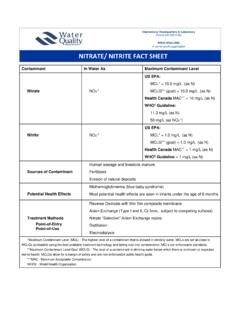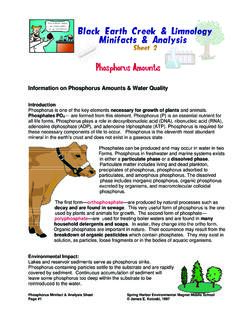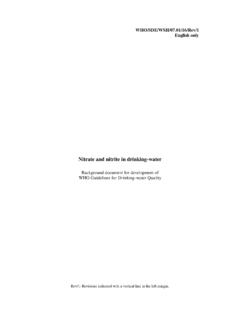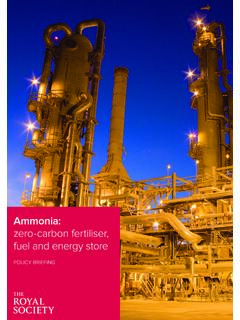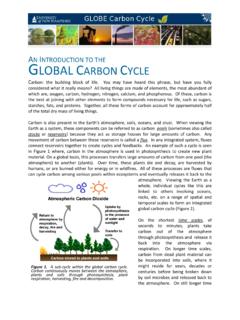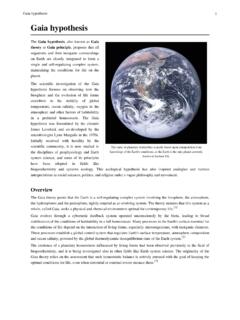Transcription of 10.2 Chemical Wood Pulping - United States Environmental ...
1 Chemical Wood GeneralChemical wood Pulping involves the extraction of cellulose from wood by dissolving thelignin that binds the cellulose fibers together. The 4 processes principally used in Chemical pulpingare kraft, sulfite, neutral sulfite semichemical (NSSC), and soda. The first 3 display the greatestpotential for causing air pollution. The kraft process alone accounts for over 80 percent of thechemical pulp produced in the United States . The choice of Pulping process is determined by thedesired product, by the wood species available, and by economic Kraft Process Description1-The kraft Pulping process (see Figure ) involves the digesting of wood chips at elevatedtemperature and pressure in "white liquor", which is a water solution of sodium sulfide and sodiumhydroxide.
2 The white liquor chemically dissolves the lignin that binds the cellulose fibers are 2 types of digester systems, batch and continuous. Most kraft Pulping is done inbatch digesters, although the more recent installations are of continuous digesters. In a batch digester,when cooking is complete, the contents of the digester are transferred to an atmospheric tank usuallyreferred to as a blow tank. The entire contents of the blow tank are sent to pulp washers, where thespent cooking liquor is separated from the pulp. The pulp then proceeds through various stages ofwashing, and possibly bleaching, after which it is pressed and dried into the finished product. The"blow" of the digester does not apply to continuous digester balance of the kraft process is designed to recover the cooking chemicals and heat.
3 Spentcooking liquor and the pulp wash water are combined to form a weak black liquor which isconcentrated in a multiple-effect evaporator system to about 55 percent solids. The black liquor isthen further concentrated to 65 percent solids in a direct-contact evaporator, by bringing the liquor intocontact with the flue gases from the recovery furnace, or in an indirect-contact concentrator. Thestrong black liquor is then fired in a recovery furnace. Combustion of the organics dissolved in theblack liquor provides heat for generating process steam and for converting sodium sulfate to sodiumsulfide. Inorganic chemicals present in the black liquor collect as a molten smelt at the bottom of smelt is dissolved in water to form green liquor, which is transferred to a causticizing tankwhere quicklime (calcium oxide) is added to convert the solution back to white liquor for return to thedigester system.
4 A lime mud precipitates from the causticizing tank, after which it is calcined in alime kiln to regenerate process heating, for driving equipment, for providing electric power, etc., many mills needmore steam than can be provided by the recovery furnace alone. Thus, conventional industrial boilersthat burn coal, oil, natural gas, or bark and wood are commonly (Reformatted 1/95)Wood Products FACTORS(Reformatted 1/95) 9/90 Figure Typical kraft sulfate Pulping and recovery Emissions And Controls1-7-Particulate emissions from the kraft process occur largely from the recovery furnace, the limekiln and the smelt dissolving tank. These emissions are mainly sodium salts, with some calcium saltsfrom the lime kiln.
5 They are caused mostly by carryover of solids and sublimation and condensationof the inorganic control is provided on recovery furnaces in a variety of ways. In mills with eithercyclonic scrubber or cascade evaporator as the direct-contact evaporator, further control is necessary,as these devices are generally only 20 to 50 percent efficient for particulates. Most often in thesecases, an electrostatic precipitator (ESP) is employed after the direct-contact evaporator, for an overallparticulate control efficiency of from 85 to more than 99 percent. Auxiliary scrubbers may be addedat existing mills after a precipitator or a venturi scrubber to supplement older and less efficient primaryparticulate control control on lime kilns is generally accomplished by scrubbers.
6 Electrostaticprecipitators have been used in a few mills. Smelt dissolving tanks usually are controlled by meshpads, but scrubbers can provide further characteristic odor of the kraft mill is caused by the emission of reduced sulfurcompounds, the most common of which are hydrogen sulfide, methyl mercaptan, dimethyl sulfide, anddimethyl disulfide, all with extremely low odor thresholds. The major source of hydrogen sulfide isthe direct contact evaporator, in which the sodium sulfide in the black liquor reacts with the carbondioxide in the furnace exhaust. Indirect contact evaporators can significantly reduce the emission ofhydrogen sulfide. The lime kiln can also be a potential source of odor, as a similar reaction occurswith residual sodium sulfide in the lime mud.
7 Lesser amounts of hydrogen sulfide are emitted withthe noncondensables of offgases from the digesters and multiple-effect mercaptan and dimethyl sulfide are formed in reactions with the wood component,lignin. Dimethyl disulfide is formed through the oxidation of mercaptan groups derived from thelignin. These compounds are emitted from many points within a mill, but the main sources are thedigester/blow tank systems and the direct contact odor control devices, per se, are not generally found in kraft mills, emitted sulfurcompounds can be reduced by process modifications and improved operating conditions. For example,black liquor oxidation systems, which oxidize sulfides into less reactive thiosulfates, can considerablyreduce odorous sulfur emissions from the direct contact evaporator, although the vent gases from suchsystems become minor odor sources themselves.
8 Also, noncondensable odorous gases vented from thedigester/blow tank system and multiple effect evaporators can be destroyed by thermal oxidation,usually by passing them through the lime kiln. Efficient operation of the recovery furnace, byavoiding overloading and by maintaining sufficient oxygen, residence time, and turbulence,significantly reduces emissions of reduced sulfur compounds from this source as well. The use offresh water instead of contaminated condensates in the scrubbers and pulp washers further reducesodorous new mills have incorporated recovery systems that eliminate the conventional direct-contact evaporators. In one system, heated combustion air, rather than fuel gas, provides direct-contactevaporation.
9 In another, the multiple-effect evaporator system is extended to replace the direct-contactevaporator altogether. In both systems, sulfur emissions from the recovery furnace/direct-contactevaporator can be reduced by more than 99 (Reformatted 1/95)Wood Products dioxide is emitted mainly from oxidation of reduced sulfur compounds in the recoveryfurnace. It is reported that the direct contact evaporator absorbs about 75 percent of these emissions,and further scrubbing can provide additional sources of carbon monoxide emissions from the kraft process include the recoveryfurnace and lime kilns. The major cause of carbon monoxide emissions is furnace operation wellabove rated capacity, making it impossible to maintain oxidizing nitrogen oxides also are emitted from the recovery furnace and lime kilns, althoughamounts are relatively small.
10 Indications are that nitrogen oxide emissions are on the order of kilograms per air-dried megagram (kg/Mg) (1 to 2 pounds per air-dried ton [lb/ton]) of pulpproduced from the lime kiln and recovery furnace, major source of emissions in a kraft mill is the boiler for generating auxiliary steam andpower. The fuels are coal, oil, natural gas, or bark/wood waste. See Chapter 1, "External CombustionSources", for emission factors for presents emission factors for a conventional kraft mill. The most widely usedparticulate control devices are shown, along with the odor reductions through black liquor oxidationand incineration of noncondensable offgases. Tables , , , , , and cumulative size distribution data and size-specific emission factors for particulate emissionsfrom sources within a conventional kraft mill.











